Hole in the Clouds
Jun 3, 2011
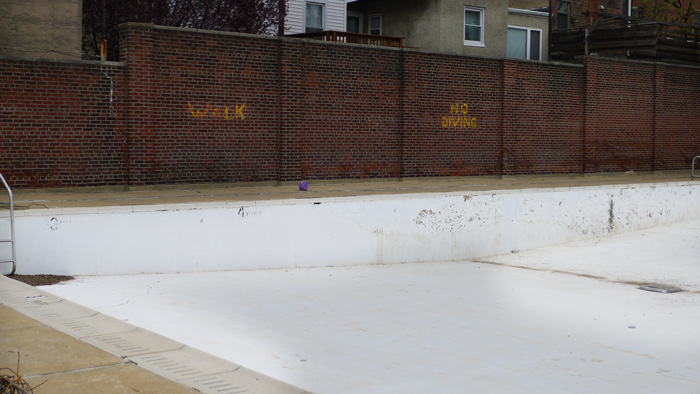 Like most American local governments, the city of Philadelphia is pretty much broke and can't afford to operate its public swimming pools.
Like most American local governments, the city of Philadelphia is pretty much broke and can't afford to operate its public swimming pools.
Two summers ago, the pools never did open. Last summer, neighborhood fundraising financed a few weeks of swimtime in July and August. This summer, we're told, fundraising has been successful enough to open the pool in our neighborhood for a few extra weeks, beginning in mid-June when school lets out.
Rumor has it that one Philadelphia neighborhood is financing its pool operation with a high-stakes Cowpie Bingo game. If you're not familiar with Cowpie Bingo, it's really one of the best games you can play with a rented cow. You mark a grid on a small field of grass and sell chances on squares in the grid; half the take goes to the cause–in this case, lifeguard salaries and tanks of chlorine–and the other half goes to the lucky person who bought the square where the cow deposits whatever she deposits.
The Philadelphia swimming pool cowpie bingo game is said to offer $10,000 to the winner, if the cow cooperates by depositing her pie neatly within a single square of the grid.
This may or may not prove a good financial model for twenty-first-century urban government. Until we know for sure, that No Diving thing is probably a really good idea.
sports
Philadelphia
swimming
neighborhood
empty
Aug 25, 2011
 Sadly, this is a "before" picture: the big American Elm tree in the courtyard of Shiloh Baptist Church in our neighborhood has been diagnosed with Dutch Elm Disease and is about to be cut down.
Sadly, this is a "before" picture: the big American Elm tree in the courtyard of Shiloh Baptist Church in our neighborhood has been diagnosed with Dutch Elm Disease and is about to be cut down.
I'm told this tree made a cameo appearance in The Sixth Sense, a Bruce Willis movie shot in the neighborhood, but I can't confirm or deny. There's a pivotal scene near the end of the movie in which the boy and his mother sit talking in the car, which is stopped near the scene of an accident; there's a tree outside the car window on the boy's side, but all the camera shows of this tree is its lower trunk, which is not sufficient for a positive ID.
Anyway, the church building and probably also the tree date back to the 1860s, when the Church of the Holy Apostles was built to serve a neighborhood rapidly filling with immigrants from Ireland. Numerous annexes and additions were required, as the parish exceeded 10,000 by 1910. But by 1940, descendants of the Irish immigrants were leaving the neighborhood, and descendants of African slaves from the American South were pouring in. The church complex was sold to a Baptist congregation and renamed Shiloh.
Today, Shiloh's congregants have mostly left the neighborhood, replaced this time by newcomers who mostly grew up in middle-class suburbs; one long-time resident described the new neighbors to a newspaper reporter as "white people with big dogs." Churchgoers who've moved away return to Shiloh on Sunday mornings, causing traffic jams and parking conflicts. There is no church parking lot; for the church's first hundred-plus years, people got there by walking.
The congregation is shrinking fast and is already far too small to maintain the huge church complex. The elm will come down in the next few weeks; the building, designed by the iconic Philadelphia architect Frank Furness, may not be far behind.
Pennsylvania
streetscape
tree
Philadelphia
neighborhood
Shiloh Baptist Church
Graduate Hospital
Dutch Elm Disease
(Photo credit: L. Blanchard)
Mar 19, 2012

I have it on very good authority that these princesses were on their way to the drug store.
children
streetscape
Philadelphia
Kater Street
neighborhood
costumes
Mar 22, 2012
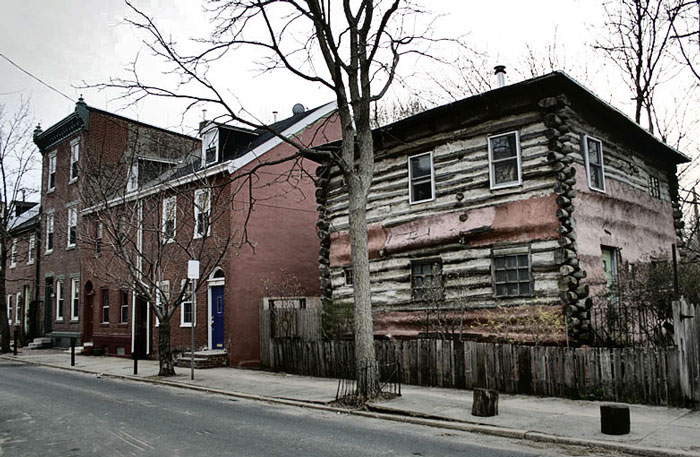 Philadelphia is a city of brick row houses, block upon block, mile after mile. But this house on Lawrence Street in Northern Liberties looks a little different; for one thing, it's detached from all its neighbors, set back from the street in a large fenced yard. And for another thing, well, it's a log cabin. Two stories high, a citified height, but still, unquestionably, a log cabin.
Philadelphia is a city of brick row houses, block upon block, mile after mile. But this house on Lawrence Street in Northern Liberties looks a little different; for one thing, it's detached from all its neighbors, set back from the street in a large fenced yard. And for another thing, well, it's a log cabin. Two stories high, a citified height, but still, unquestionably, a log cabin.
It doesn't date back to the "real" log-cabin age, however. About a quarter-century ago, in the mid-1980s, an artist named Jeff Thomas put the cabin together from a load of logs trucked in from West Virginia; its stylistic allusion, we're told, is to the back-to-the-landers of the 1960s and early '70s. In the 1980s, Thomas and other artists then settling in the Northern Liberties section of Philadelphia were recolonizing a city landscape of abandoned factories, decrepit warehouses, vacant lots, and boarded-up, blighted homes. Their pioneering spirit, embodied in Thomas's house, succeeded only too well, and the cabin is now surrounded by renovated homes that cost way too much for a struggling artist.
streetscape
Philadelphia
houses
neighborhood
Northern Liberties
(Image credit: Steve Ives)
Apr 22, 2012
 This tree was the very first one that got itself planted Saturday morning by these tree-planting students; immediately after posing for this tree-planting graduation photo, the class split up into crews and planted about fifteen more trees around the neighborhood, as part of Philadelphia's Million Trees Project.
This tree was the very first one that got itself planted Saturday morning by these tree-planting students; immediately after posing for this tree-planting graduation photo, the class split up into crews and planted about fifteen more trees around the neighborhood, as part of Philadelphia's Million Trees Project.
This is a gingko tree, apparently the Fairmount Park gingko variety developed in Philadelphia specifically for urban settings. It has a more columnar growth habit than other gingkos, making it useful on narrow sidewalks or in other locations where there's little room for trees with spreading canopies. Frank Lloyd Wright was said to particularly admire the Fairmount Park gingkos, which he often utilized in landscaping around houses he designed in the Chicago area.
streetscape
tree
Philadelphia
neighborhood
Lombard Street
Derrick
Friends of Schuylkill River Park
Fairmount Park Gingko
Apr 25, 2012
 Where this building now almost stands and in the streets around it, back in the day, the neighborhood kids used to be so bold and bad that the parish priest described them as children who'd steal a chain from right out of the devil's pocket. And so this part of the neighborhood got its name, Devil's Pocket, which was home to poor people, of course, mostly Irish immigrants.
Where this building now almost stands and in the streets around it, back in the day, the neighborhood kids used to be so bold and bad that the parish priest described them as children who'd steal a chain from right out of the devil's pocket. And so this part of the neighborhood got its name, Devil's Pocket, which was home to poor people, of course, mostly Irish immigrants.
A generation or two later, a bunch of the little old houses in Devil's Pocket were torn down to build a parking garage, apparently intended for employees of the old Graduate Hospital. Most of that hospital is long gone, and now, in the spring of 2012, the wrecking ball has come for the derilict parking garage.
It sounds a little cheeky, but by this time next year, there will be fancy new condos right here in the Devil's Pocket. And the wrecking ball will toll for some other something.
cityscape
streetscape
demolition
Philadelphia
construction
neighborhood
Graduate Hospital
urban decay
May 29, 2012

The machine that's demolishing Mt. Olive AME Church in the neighborhood is something you can rent in New Jersey. The jaws at the business end of the thing are heavy-duty grapples; you rent a regular excavating machine on caterpillar treads, remove its digging bucket, and pin on the grapple. The two-tined jaw opens and closes against the stationary three-tined jaw, which is reinforced, as seen here, with a rod called, appropriately enough, a stiff arm.
The cultural and economic forces that are demolishing Mt. Olive AME Church and a whole host of other churches in the neighborhood are something else again. These church buildings, many of them built from stone like this one, have sat here for a hundred years or so, sometimes changing denominations as the nearby population changed. The latest wave of immigrants to the neighborhood doesn't seem very churched at all, and so the old buildings get put on the market. Developers snatch them up and tear them down for a chance to build several new houses at once, in a part of the city that's already densely built. New houses--row houses--sell readily here to people who want to walk to work and/or to stores and restaurants. The new residents evidently are not interested in walking to church.
Soon, the excavator and its grapple will be loaded on a truck to go back to the heavy equipment lot in New Jersey, and we'll see five three-story row houses rise up on this lot, with squared-off bay windows and ten-year tax exemptions.
demolition
Philadelphia
work
neighborhood
church
heavy machinery
history
demographic change
Mt. Olive AME Church
Jun 28, 2012
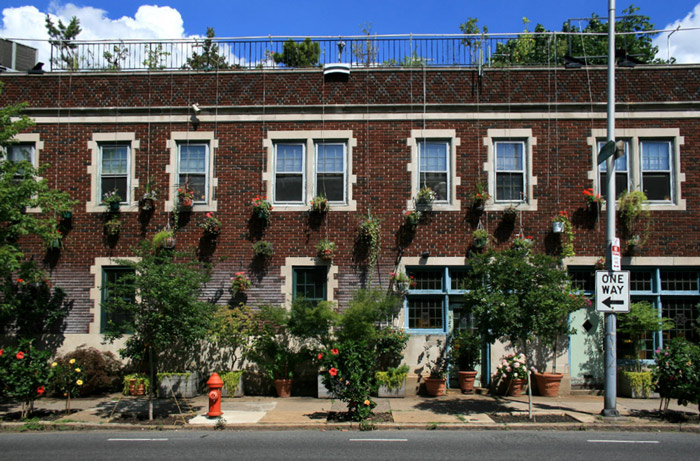 In hot weather, watering all this must be a serious chore. The greenery actually wraps around the corner from 22nd Street, shown here, onto Pine Street. Some of it is edible; all of it is awesome.
In hot weather, watering all this must be a serious chore. The greenery actually wraps around the corner from 22nd Street, shown here, onto Pine Street. Some of it is edible; all of it is awesome.
garden
streetscape
flowers
Philadelphia
neighborhood
building
Fitler Square
22nd Street
(Image credit: Steve Ives)
Nov 12, 2012
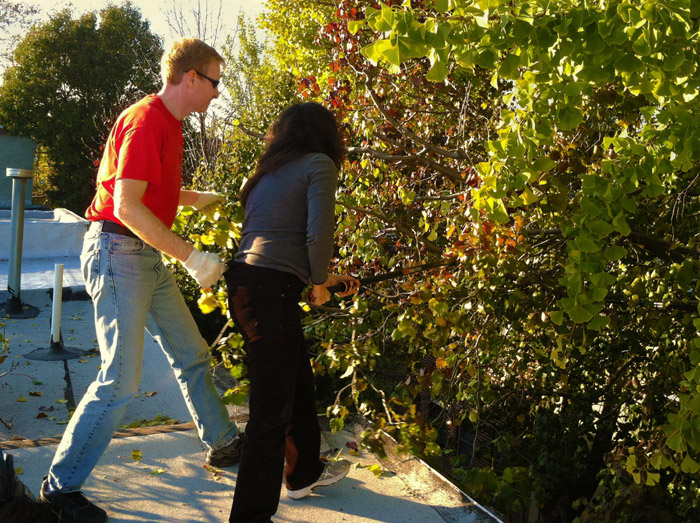 When you get a day in November that's t-shirt warm, it just seems right to get up on the roof. There were drainspouts to clear and trees to trim, debris to sweep up and . . . pictures to take.
When you get a day in November that's t-shirt warm, it just seems right to get up on the roof. There were drainspouts to clear and trees to trim, debris to sweep up and . . . pictures to take.
Today's rooftop picture features our neighbors Carolyn and Frank; Carolyn works the pole trimmer while Frank hooks a finger in her beltloop to keep her safe.
Looking into the treetops, it became obvious that this year's fall weather has mostly been so mild that the leaves are only just now beginning to behave fallishly. But we trimmed the trees back so far that almost all the remaining leaves will eventually drop on the street or the sidewalk, not on top of the houses.
streetscape
Philadelphia
Kater Street
work
roof
neighborhood
trees
Frank
Carolyn
Nov 21, 2012
 He loves his dog, which we were told weighs 72 pounds. And he loves to ride his dog down the sidewalk on Rodman Street. You got a problem with that?
He loves his dog, which we were told weighs 72 pounds. And he loves to ride his dog down the sidewalk on Rodman Street. You got a problem with that?
dog
children
streetscape
Philadelphia
neighborhood
pets
Apr 8, 2013
 Pace, Mother Maybelle.
Pace, Mother Maybelle.
streetscape
Philadelphia
spring
Kater Street
neighborhood
May 3, 2013
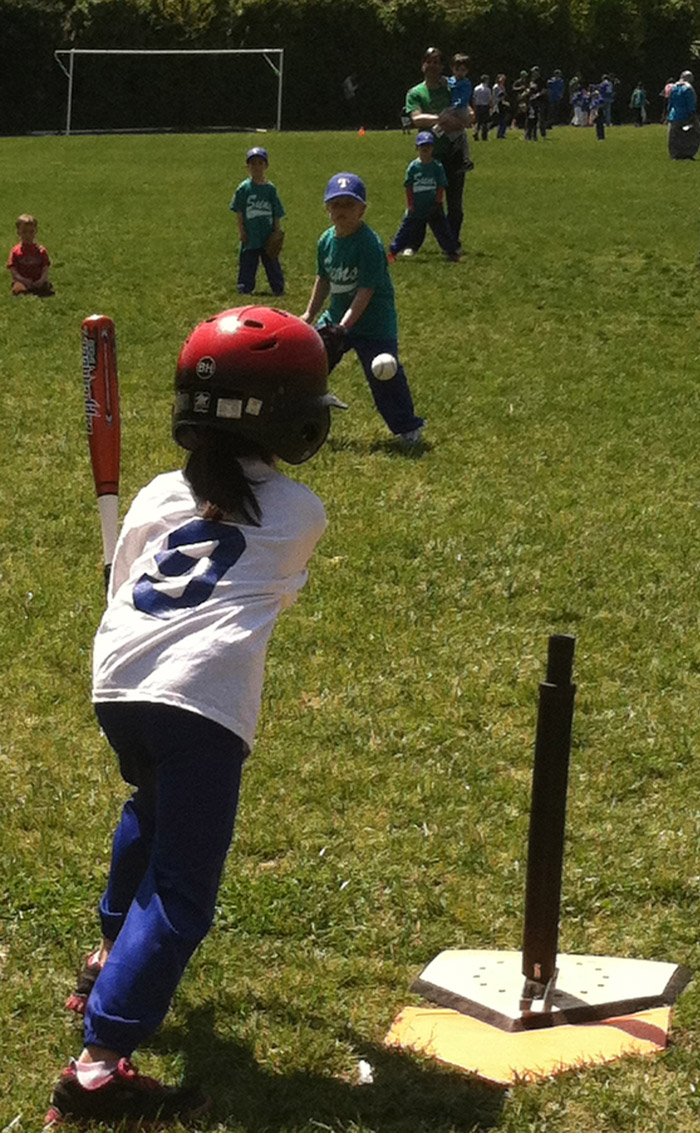 It's t-ball time at Taney Field in Schuylkill River Park.
It's t-ball time at Taney Field in Schuylkill River Park.
sports
children
Philadelphia
Schuylkill River Park
neighborhood
Lily
t-ball
Jul 29, 2013
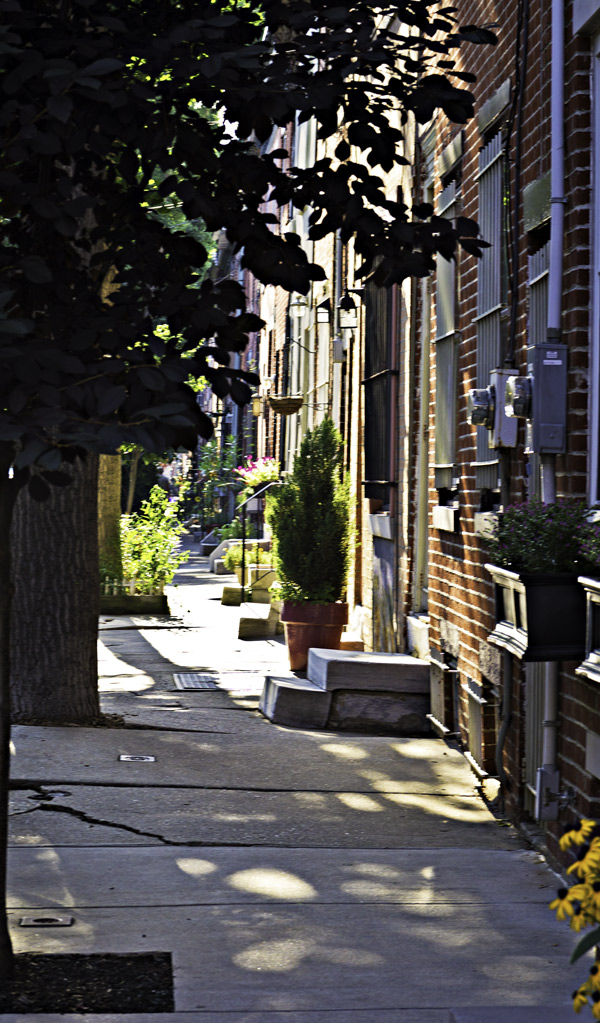
As leafy as the trees may be, when the summer sun takes aim at bricks and concrete, the light will find a way.
summer
streetscape
flowers
Philadelphia
Kater Street
neighborhood
Sep 21, 2013
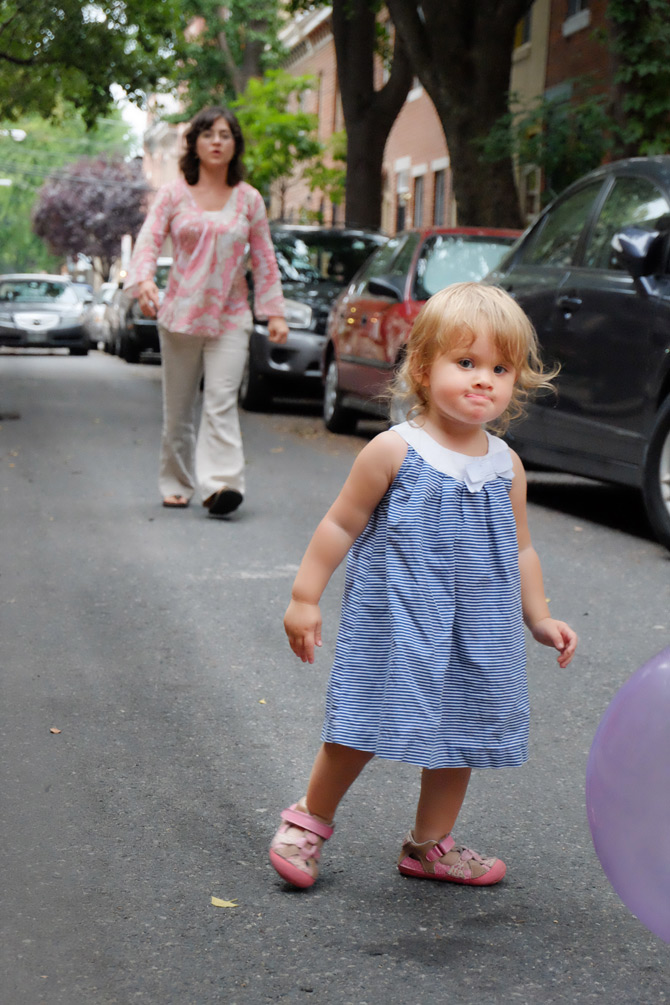
children
streetscape
Kater Street
neighborhood
Philly
Maizie
(Image credit: Little Fuji)
Oct 5, 2013
 There's a new mural in the neighborhood, bolted high on the wall of a new house at the corner of Fitzwater and Smedley. Looks to be a private project, not part of the city's Mural Arts Program, and it's hard to say if it's intended as permanent street art, since it mostly blocks the windows of the house. But it's something to look at, a portrait of Nelson Mandela looming above a scrim of drippy red and black streaks. The painter signed the mural illegibly; we believe that whoever he or she is, he or she got it right, those dark, worldly, heavy-lidded eyes in a brilliant red face.
There's a new mural in the neighborhood, bolted high on the wall of a new house at the corner of Fitzwater and Smedley. Looks to be a private project, not part of the city's Mural Arts Program, and it's hard to say if it's intended as permanent street art, since it mostly blocks the windows of the house. But it's something to look at, a portrait of Nelson Mandela looming above a scrim of drippy red and black streaks. The painter signed the mural illegibly; we believe that whoever he or she is, he or she got it right, those dark, worldly, heavy-lidded eyes in a brilliant red face.
art
house
streetscape
mural
neighborhood
Nelson Mandela
Oct 7, 2013
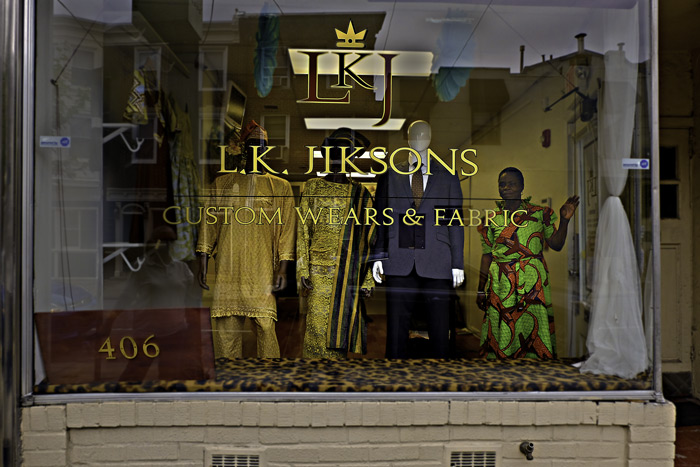 In the shop window of L.K. Jikson's on South 20th Street, a few blocks from Rittenhouse Square, stands a woman wearing a dress made of fabric printed in chartreuse, orange, and maroon. Click on the picture to see an enlarged view: the maroon shapes in the print are actually jet airliners.
In the shop window of L.K. Jikson's on South 20th Street, a few blocks from Rittenhouse Square, stands a woman wearing a dress made of fabric printed in chartreuse, orange, and maroon. Click on the picture to see an enlarged view: the maroon shapes in the print are actually jet airliners.
streetscape
window
neighborhood
storefront
Philly
windowscape
African
fabric
(Image credit: Little Fuji)
Nov 3, 2013

By the sackful at Gavin's Cafe near Schuylkill River Park.
work
neighborhood
restaurant
Philly
Fitler Square
Pine Street
(Image credit: Little Fuji)
Nov 23, 2013
 They're gutting yet another house in the neighborhood.
They're gutting yet another house in the neighborhood.
house
streetscape
window
work
neighborhood
Philly
(Image credit: Little Fuji)
Nov 24, 2013

Thanks to the work of this volunteer and many hundreds of others, Philadelphia got 850 new street trees on Saturday, bringing the overall regional total of trees planted to–according to the calculations of somebody or other, as of Saturday night–exactly 262,236.
The goal is a million new trees, in hopes of restoring the forest canopy area heareabouts to 30%, which would provide enough shade to significantly mitigate the urban heat-island effect and would improve air and water quality, reduce erosion and water pollution, and lessen the frequency and severity of flooding.
The tree roots at bottom right in this photo belong to a variety of maple tree that is particularly hardy in urban settings and has a growth habit suitable for its new home in the urban jungle on South 21st Street, in front of a dentist's office and across the street from a dry cleaner's.
streetscape
work
neighborhood
trees
Philly
volunteer
(Image credit: Little Fuji)
Jan 4, 2014
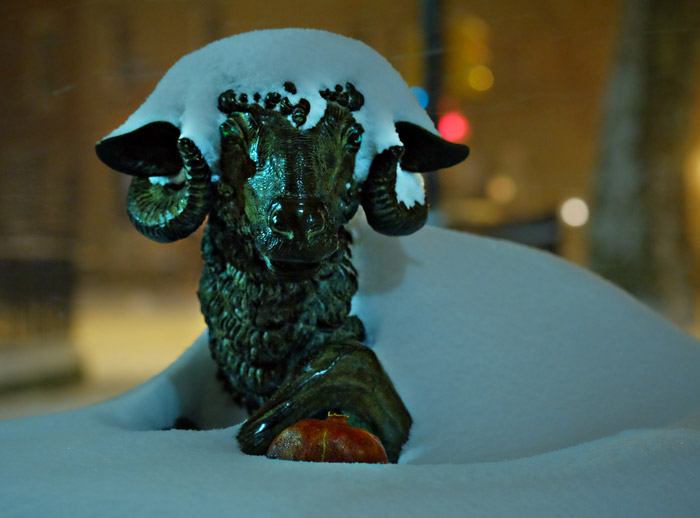 Last night, we saw a ram with a pomegranate in Fitler Square, Philadelphia.
Last night, we saw a ram with a pomegranate in Fitler Square, Philadelphia.
night
winter
sculpture
snow
Philadelphia
fruit
neighborhood
bronze
park
Fitler Square
ram
(Image credit: Hank Stein)
Jan 6, 2014
 After devoting an entire snow day to building herself a Lego boat, Lily determines that the crowning touch will be a banana.
After devoting an entire snow day to building herself a Lego boat, Lily determines that the crowning touch will be a banana.
Kater Street
neighborhood
Lily
Philly
Lego
banana
(Image credit: Little Fuji)
Jan 22, 2014
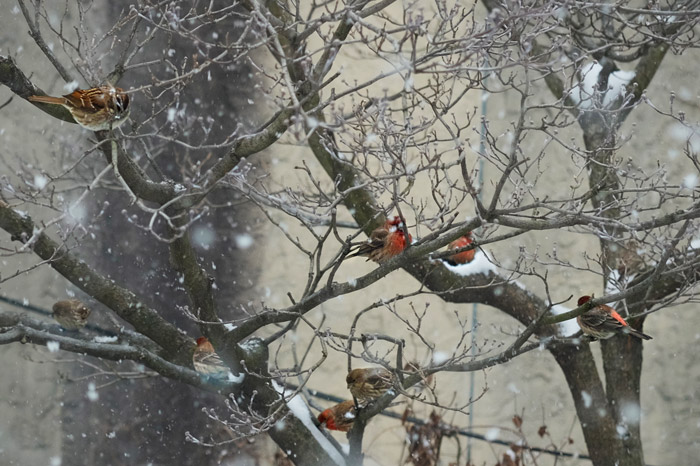 On a day like this, all the neighborhood cats stayed indoors snoozing by the heater.
On a day like this, all the neighborhood cats stayed indoors snoozing by the heater.
tree
snow
Kater Street
birds
neighborhood
Philly
alley
(Image credit: Little Fuji)
Jan 23, 2014

night
streetscape
winter
snow
Kater Street
neighborhood
Philly
street
(Image credit: Little Fuji)
Feb 17, 2014
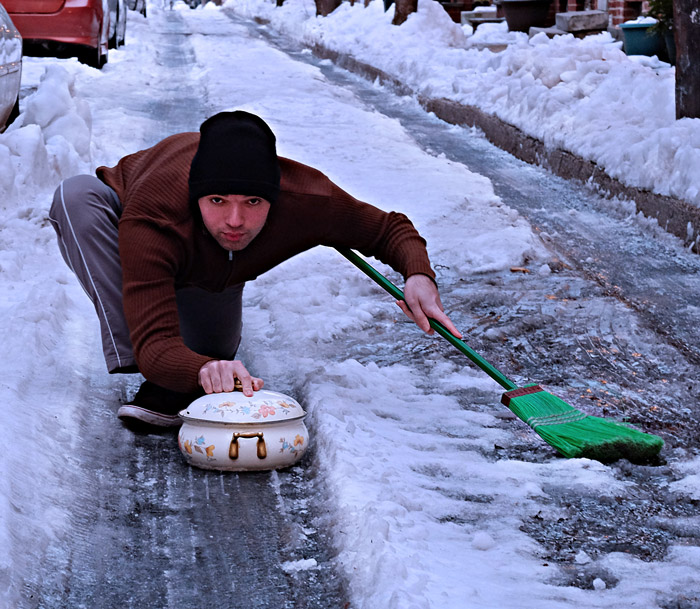 Marco's rock is right on track for the U.S. of A.
Marco's rock is right on track for the U.S. of A.
sports
streetscape
winter
snow
ice
Kater Street
neighborhood
Marco Bonnes
Olympics
broom
(Image credit: Little Fuji)
Jun 2, 2014
 Every day in Philadelphia, houses are declared dead, mostly after long years of painful dilapidation and decay. If they don't collapse or crumble of their own weight, they are demolished, eventually, without ceremony; the machines show up, and the trucks haul away the pieces.
Every day in Philadelphia, houses are declared dead, mostly after long years of painful dilapidation and decay. If they don't collapse or crumble of their own weight, they are demolished, eventually, without ceremony; the machines show up, and the trucks haul away the pieces.
Until Saturday, 3711 Melon Street in West Philly's Mantua neighborhood was no different from all the others. It had sheltered families since 1872. The last owner was Leona Richardson, who bought it in 1946 and brought up her son Roger there. Mantua was a good place to raise a family; the neighbors were poor, but they looked after one another, and they had stores, schools, churches, a post office, a movie theater, a firehouse. The houses were small and already old, rotting, cracking, always needing some kind of repair, but a single mother like Leona Richardson could afford to buy a home of her own in Mantua, and could live there comfortably and see her son grow up and get an education.
Eventually, Miss Leona paid off the house on Melon Street and bought another place a few blocks away, where she lived until her death in 2002. Even before she died, the old house was becoming harder and harder to keep up; after she died, it was basically abandoned. Today, shells of houses like 3711 Melon Street are offered for sale in the neighborhood for $30,000; they languish on the market; nobody thinks they're worth that much. They're 140 years old now, and in recent years they've been better homes for rats than for people.
People have tried to find shelter in them, of course. Drunks and addicts have used them when they could. Drug wars have been fought in and around them. Neighborhood children died in some of these empty houses.
The neighborhood as a whole was grievously wounded, losing families and homes and businesses and city services, and when finally the worst of the houses were sold for scrap, ripped apart and hauled away, the wounds in the fabric of the neighborhood became scars, marks of permanent disfiguring damage. Now only weeds grow tall where once families had flourished. There are more and more gaps in the blocks of rowhouses, ugly gaps, like missing teeth.
But the passing of 3711 Melon Street last Saturday did not go quietly. A proper funeral was observed, complete with flowers, organ, remembrances, eulogy, black armbands, folding fans, food, and "Leaning on the Everlasting Arms." There were printed programs, with color photos of the deceased. And when the machine tore into the house, pallbearers were at the ready, accompanying the dumpster load of what was once a home to its place of final repose.
Needless to say, the funeral for 3711 Melon Street was observed in such a public manner because politicians and community organizers were wanting to draw attention to some of their work. The ground on which the lost house had stood will become part of a parcel slated for development as affordable housing. "Plan, or be planned for," several of the speakers told the gathering.
"I've learned that you can tell a lot about a person," one of the speakers noted, quoting the very recently departed Maya Angelou, "by the way she handles these three things: a rainy day, lost luggage, tangled Christmas tree lights."
The neighbors of Mantua have had to handle a hell of a lot more than those three things. Our thoughts are with them as they deal with this fresh loss.



house
streetscape
Philadelphia
neighborhood
West Philly
Mantua
funeral
3711 Melon St
Mt. Olive Baptist Church
(Image credit: Little Fuji)
Jul 15, 2014

cat
Kater Street
window
neighborhood
Philly
b&w
(Image credit: Little Fuji)
Jul 26, 2014
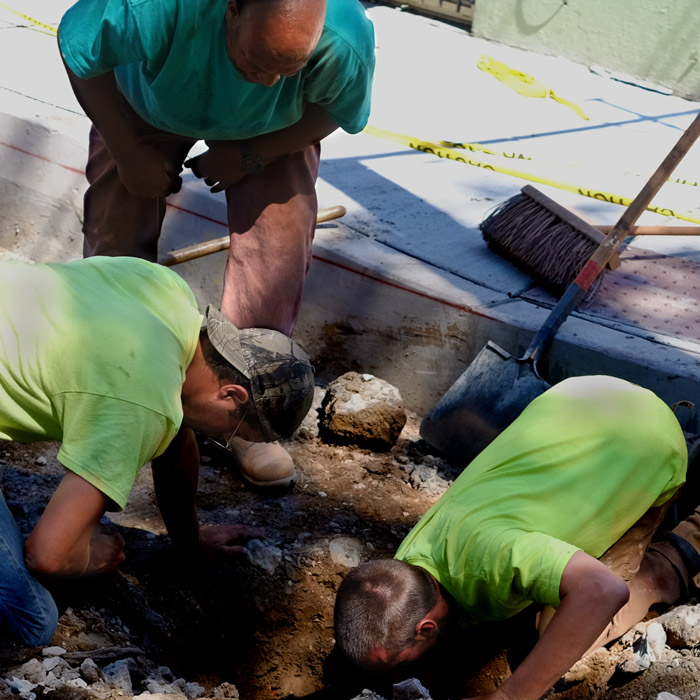 The neighbors who live along the west side of a block of 21st Street near Kater had noticed that their cold water wasn't cold any more. Right out of the tap, it was hot; one of them took its temperature and found it feverish, over a hundred degrees, which is hot enough for a nice hot shower.
The neighbors who live along the west side of a block of 21st Street near Kater had noticed that their cold water wasn't cold any more. Right out of the tap, it was hot; one of them took its temperature and found it feverish, over a hundred degrees, which is hot enough for a nice hot shower.
They called the water department, which promised to look into it. But the guys we talked to Friday morning who'd been sent to look into it might be described as less than entirely sympathetic. "They're getting free hot water," is how one of them put it. "Free hot water, and they're not happy."
The water guys suspected a leak in the steam line that runs under the sidewalk along 21st Street, which sounds like a dangerous situation, though nobody was acting particularly worried.
The guys from the steam company, on the other hand, suspected erosion under the sidewalk in the aftermath of a water main break a couple of years ago; they believed there was no longer enough dirt down there to insulate the steam line.
For reasons we cannot fully fathom, both sets of guys were looking for evidence in the sewer lines. The crew pictured here took the low-tech approach, using shovels and eyeballs; another crew had fancier technology, basically a snake with a video camera at its head, transmitting images onto a screen set up in the back of a van.
We asked what they were seeing on the screen. "Nothing yet," they said. "Just sewer."
We asked what they were looking for. They kind of snorted. "Steam," they said.
By mid-afternoon, everybody had packed up and gone home. We're not sure if they saw any steam, but the neighbors are still getting free hot water.
streetscape
Kater Street
infrastructure
neighborhood
holes
digging
Philly
steam
working
(Image credit: Fuji T)
Jul 23, 2014
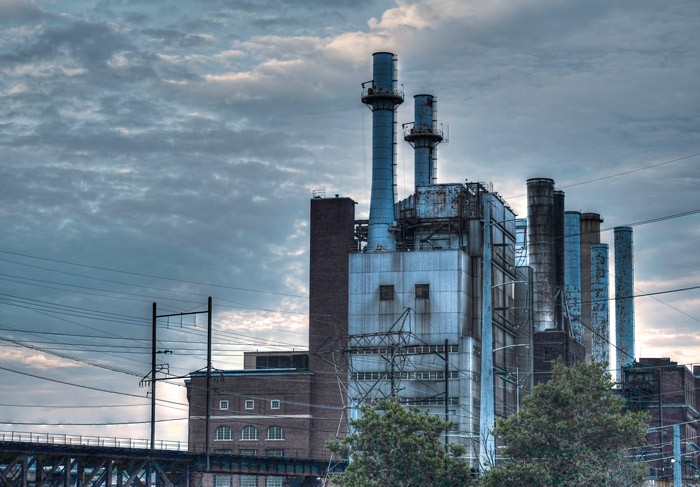 At this power plant at the edge of the neighborhood, the smokestacks that once belched day and night have been quiet now for a couple of years.
At this power plant at the edge of the neighborhood, the smokestacks that once belched day and night have been quiet now for a couple of years.
Power is still generated here at the Schuylkill complex on Grays Ferry Road, but at a newer facility immediately behind the one pictured above. Veolia Energy bought the newer part of the plant from Philadelphia's municipal electric company and converted its fuel source from oil to natural gas; that single modification reduced greenhouse gas emissions for the city as a whole, it is said, by almost 2 percent, equivalent to taking 60,000 cars off the road.
Veolia makes steam here for center city Philadelphia's centralized heating. And it does release a little smoke, not from these stacks but from a chimney behind them, not visible in the picture.
Schuylkill River
neighborhood
factory
Philly
PECO
(Image credit: Fuji T)
Aug 12, 2014

Next week, for the first time in Little League history, a team of 12- and 13-year-olds from the city of Philadelphia will be playing in the World Series in Williamsport, PA.
They are our Taney Dragons, who play at Taney Field in our neighborhood's Schuylkill River Park. To wangle an invitation to the big dance, the Dragons had to pull off a string of upsets, becoming the first Philly team ever to win districts, to win regionals, to win states, and then last week to win the Mid-Atlantic championship.
The way Little League works, it's almost always the well-funded suburban operations that come away with the postseason prizes. Taney had to raise money all year long to go out for these tournaments; they scrounged for practice fields all over the city, sometimes using a hangar out by the airport. Many of the parents can't afford to travel to watch their kids play, but they managed to raise $20,000 in a few days to send the team to Connecticut for the Mid-Atlantic tournament.
The Dragons' victory in Connecticut was a stunner; they dispatched Newark, Delaware, last year's Mid-Atlantic champions, 8-0. Their bats were hot, obviously, but their pitching was pretty much the same as always: a cool clinic of 70-mile-an-hour fastballs and heartbreaking curveballs, a shutout with just three hits allowed by the Dragons' star Mo'Ne Davis, who will be the only girl this year in the Little League World Series.
Although Little League has permitted girls to play since it was forced to by the courts in 1974, Davis is still a rarity. She says she has never pitched to a girl batter. But baseball is not really her passion; that would be basketball, her favorite sport. Her dream is to play in the WNBA.
Meanwhile, she's the Dragon who gets all the attention, which may be a good thing since she's unflappable, never discouraged or distracted, nothing at all like a typical 13-year-old. It's the boys on the team who crank up the drama, along with the energy level.
Tune in on August 15 on national TV for the Dragons' first World Series contest, against a team from South Nashville, Tennessee.
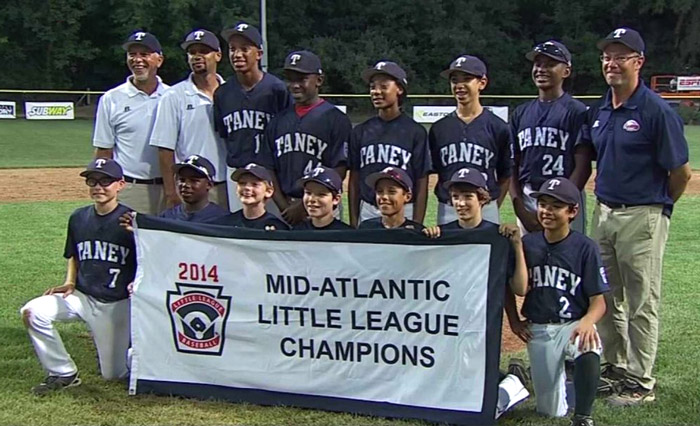
sports
baseball
neighborhood
Philly
Mo'Ne Davis
Taney
Little League
Nov 4, 2014
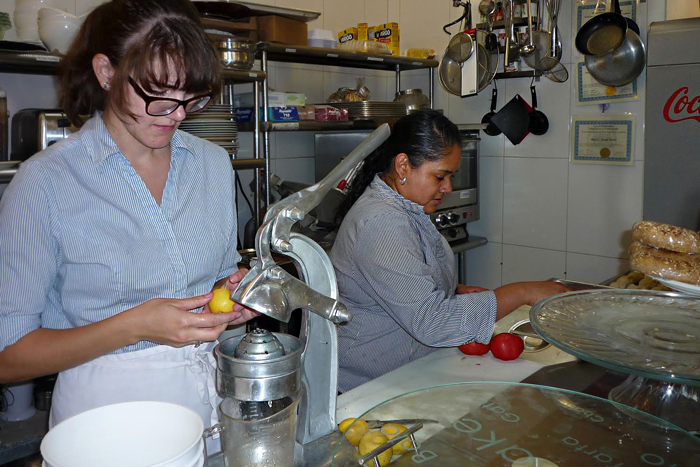 Around the middle of every October comes a day declared Philly Photo Day by the Philadelphia Photo Arts Center. Anybody who happens to be in Philly that day with any kind of camera, even a cellphone, is invited to submit a snapshot that captures a smidgen of what's going on, on that day, in this city.
Around the middle of every October comes a day declared Philly Photo Day by the Philadelphia Photo Arts Center. Anybody who happens to be in Philly that day with any kind of camera, even a cellphone, is invited to submit a snapshot that captures a smidgen of what's going on, on that day, in this city.
The nineteen hundred photos turned in this year, for the fifth iteration of the event, will be displayed next April in the new Dilworth Park plaza at City Hall.
Above is Katrin Maldre's submission, showing the action behind the back counter at Gavin's Cafe in Fitler Square. Below is my entry, featuring Grand Opening balloons outside a new pet-supply store on South Street.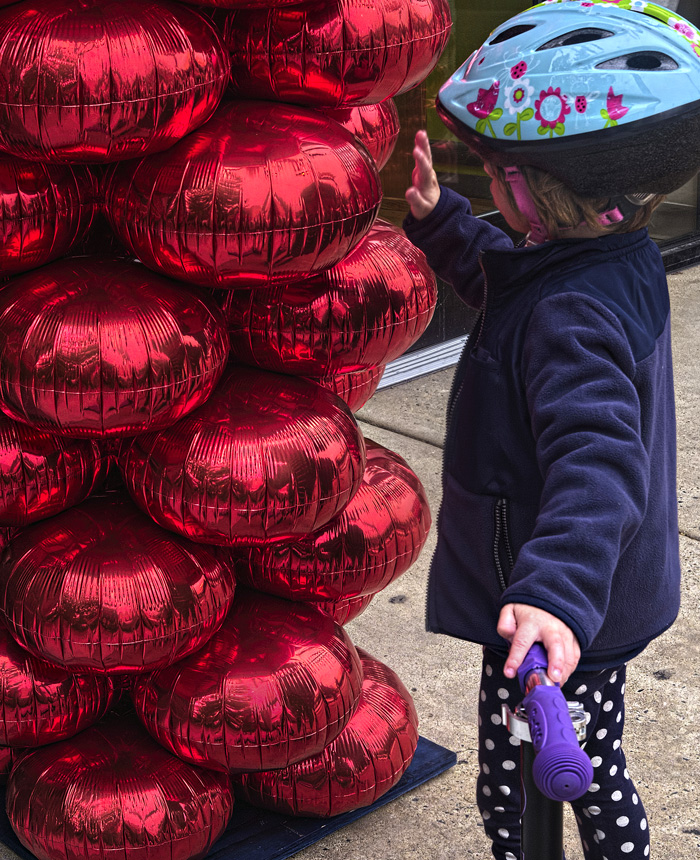
streetscape
work
neighborhood
restaurant
child
Philly Photo Day
balloons
(Image credits: K. Maldre, Fuji T)
Feb 4, 2016
 Ten or so days ago, when Philly got whacked by a pretty good thump of snow, this guy was the only one out driving around in the neighborhood, until he wasn't.
Ten or so days ago, when Philly got whacked by a pretty good thump of snow, this guy was the only one out driving around in the neighborhood, until he wasn't.
He was going the wrong way up 24th Street–and really, why not? There were no other cars on the road. But he slipped and slid, and then he was digging and digging. . . .
One of the neighbors brought him some cardboard, which was eventually helpful, but nobody offered to help him shovel, which might have made a more immediate contribution. (In our own defense, it is noted here that ever since last August, when we moved into an apartment, we no longer own a snow shovel.)
It's warmed up now and rained, and the snow is disappearing. Maybe this next month will bring us more winter, but maybe not.
cars
winter
snow
neighborhood
Philly
24th Street
(Image credit: Fuji T)
Feb 16, 2016
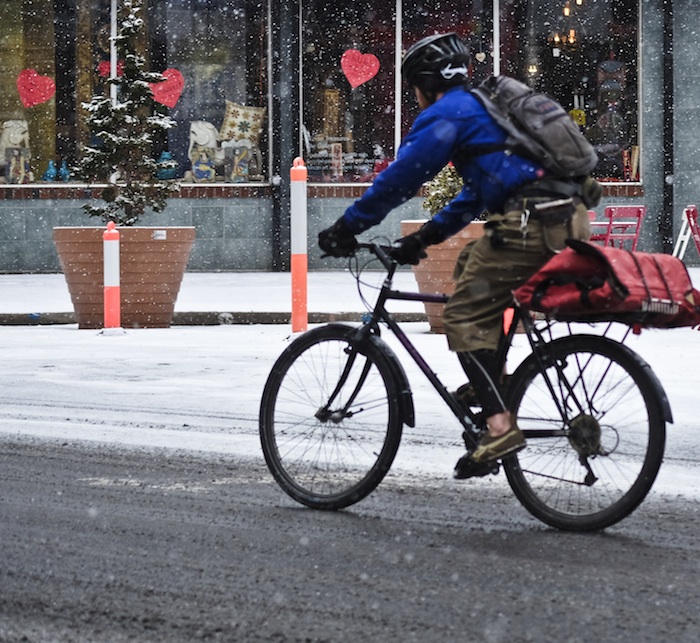 Presidents' Day has already come and gone, and they still haven't taken down the Valentine's decorations.
Presidents' Day has already come and gone, and they still haven't taken down the Valentine's decorations.
streetscape
winter
bicycle
snow
South Street
neighborhood
Philly
(Image credit: Fuji T)
Mar 1, 2018

streetscape
Cuba
neighborhood
Havana Vieja
chicos y chicas
(Image credit: the phone)
Apr 11, 2018
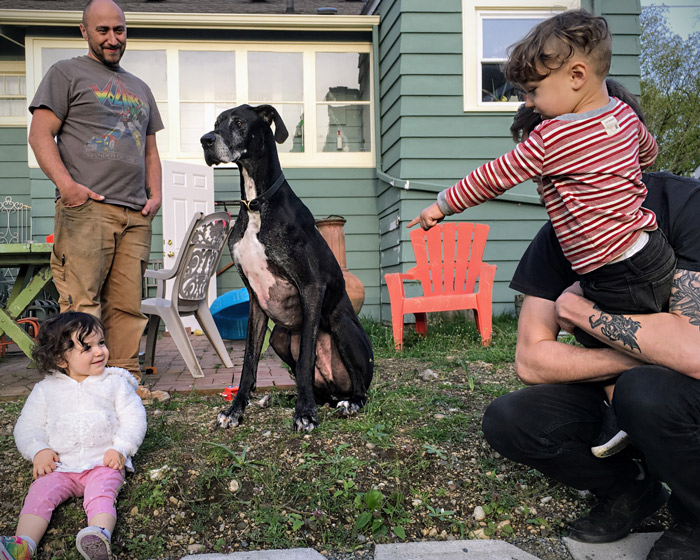 Robin goes next door and hangs out with the neighbors.
Robin goes next door and hangs out with the neighbors.
dog
backyard
neighborhood
neighbors
Robin
Bucky
(Image credit: JJ Stein)
Apr 19, 2018
 Drone's eye view of a yacht, said to be abandoned, in a Hong Kong neighborhood of government apartment towers.
Drone's eye view of a yacht, said to be abandoned, in a Hong Kong neighborhood of government apartment towers.
birdseye view
Hong Kong
neighborhood
drone
apartments
yacht
(Image credit: Trey Ratcliff via Stuck in Customs)
 Like most American local governments, the city of Philadelphia is pretty much broke and can't afford to operate its public swimming pools.
Like most American local governments, the city of Philadelphia is pretty much broke and can't afford to operate its public swimming pools.

 Philadelphia is a city of brick row houses, block upon block, mile after mile. But this house on Lawrence Street in Northern Liberties looks a little different; for one thing, it's detached from all its neighbors, set back from the street in a large fenced yard. And for another thing, well, it's a log cabin. Two stories high, a citified height, but still, unquestionably, a log cabin.
Philadelphia is a city of brick row houses, block upon block, mile after mile. But this house on Lawrence Street in Northern Liberties looks a little different; for one thing, it's detached from all its neighbors, set back from the street in a large fenced yard. And for another thing, well, it's a log cabin. Two stories high, a citified height, but still, unquestionably, a log cabin.



 When you get a day in November that's t-shirt warm, it just seems right to get up on the roof. There were drainspouts to clear and trees to trim, debris to sweep up and . . . pictures to take.
When you get a day in November that's t-shirt warm, it just seems right to get up on the roof. There were drainspouts to clear and trees to trim, debris to sweep up and . . . pictures to take. He loves his dog, which we were told weighs 72 pounds. And he loves to ride his dog down the sidewalk on Rodman Street. You got a problem with that?
He loves his dog, which we were told weighs 72 pounds. And he loves to ride his dog down the sidewalk on Rodman Street. You got a problem with that? 




























